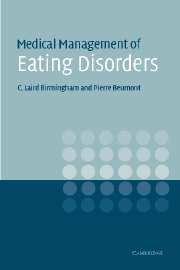Book contents
- Frontmatter
- Contents
- List of color plates
- List of contributors
- List of abbreviations
- Introduction
- PART I THE MEDICAL PERSPECTIVE
- PART II TREATMENT
- PART III SPECIAL ISSUES
- PART IV THE PSYCHIATRIC AND PSYCHOLOGICAL PERSPECTIVE
- PART V AREAS OF SPECIAL INTEREST
- 14 The role of the general practitioner
- 15 Nursing patients with anorexia nervosa
- 16 The role of the dietitian
- 17 Information for family and friends
- Bibliography
- Index
- Plate section
15 - Nursing patients with anorexia nervosa
Published online by Cambridge University Press: 18 December 2009
- Frontmatter
- Contents
- List of color plates
- List of contributors
- List of abbreviations
- Introduction
- PART I THE MEDICAL PERSPECTIVE
- PART II TREATMENT
- PART III SPECIAL ISSUES
- PART IV THE PSYCHIATRIC AND PSYCHOLOGICAL PERSPECTIVE
- PART V AREAS OF SPECIAL INTEREST
- 14 The role of the general practitioner
- 15 Nursing patients with anorexia nervosa
- 16 The role of the dietitian
- 17 Information for family and friends
- Bibliography
- Index
- Plate section
Summary
Introduction
Caring for patients with dieting disorders can be one of the most challenging and rewarding roles for nurses. However, even for the most experienced clinician, it can also be frustrating, anxiety-provoking, and emotionally draining, and nurses must be aware of the potential for burnout and emotional over- or underinvolvement.
Nurses become many things to a patient with AN, most essentially someone who is familiar with the patient's feelings, ideas, emotions, routines, rituals, and behaviors. Nurses need to be skilled in recognizing and interpreting the physiological and psychological signs, symptoms, and complications of the disorder. It is imperative that they develop AN empathic, non-judgmental approach, and that they maintain clear professional boundaries — yet a nurse's job is to challenge fixed and unrealistic beliefs and to assist in the development of motivation to change, so it is necessary to form a strong and trusting bond. As well, nurses provide information, act as role models, and support the patient and their family through the recovery process.
In order to fulfill this challenging and difficult role, nurses need education, clinical supervision, support from management and administration, collaboration and communication with other nursing colleagues, and recognition from other members of the treatment team that the nurse's role is valuable and vital.
- Type
- Chapter
- Information
- Medical Management of Eating DisordersA Practical Handbook for Healthcare Professionals, pp. 245 - 249Publisher: Cambridge University PressPrint publication year: 2004



